Three matchdays have been played in the Austrian Bundesliga since the restart and the two teams Hartberg and Sturm Graz couldn’t be in more different situations. Most fans and experts expected ahead of this season that Hartberg would be among the clubs who have to fight against the relegation, but they are part of the championship group and besides, they were in the comfortable fifth position ahead of this game and got six points out of their last three games. On the other side, Sturm Graz lost all of their first three games after the restart and are in horrible form.
Furthermore, their coach Nestor El Maestro (was already the assistant coach at the Bundesliga side Schalke 04) received a red card in the last match against RB Salzburg which means he will have to watch the upcoming four league games (including this one against Hartberg) from the stands.
In this tactical analysis, we will look at the tactics of both sides and discuss the reasons for the 2-1 win of Sturm Graz in this derby of Styria.
Lineups
Markus Schopp used a 3-4-1-2 formation with René Swete between the sticks and the back three consisted out of Thomas Rotter, Felix Luckeneder, and Christian Klem. Tobias Kainz and Bakary Nimaga were the defensive midfielders and had Rajko Rep in front of them. Andreas Lienhart and Amadou Dante played in the wide-areas and Dario Tadić partnered up with Jodel Dossou up front.
On the other side, Sturm Graz played in a 5-3-2/3-1-4-2 formation with Jörg Siebenhandl in goal. Ivan Ljubic, Anastasios Avlonitis, and Niklas Geyrhofer were the three central defenders while Emanuel Sakic and Stefan Hierländer were the wing-backs. Juan Domínguez was the defensive midfielder and was supported by Christoph Leitgeb and Otar Kiteishvili in the centre and Kiril Despodov (loanee from Serie A side Cagliari Calcio) joined Kevin Friesenbichler in the highest line.
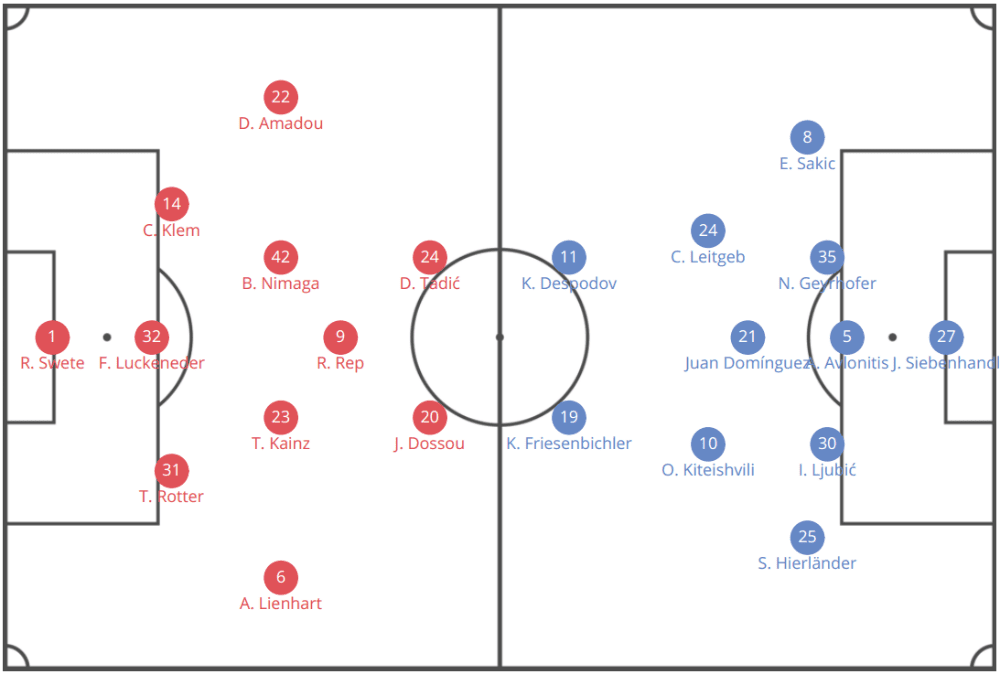
Hartberg’s domination in the first half
During the first 45 minutes of this match, Hartberg were the better side and dominated the match. Especially during the opening 30 minutes, the team of Schopp were extremely dominant and patient during the build-up. In this first part of the tactical analysis, we will look at the period of possession of Hartberg in the first half. An additional reason for their domination in the first half is also the weak performance of Sturm Graz when they were in possession, but we will look at this in the second section of this tactical analysis.
Basically, Hartberg tried to build up all of their attacks with short passes from the back. The three defenders split wide with Luckeneder in the centre who organised together with the deeper central midfielder Nimaga and the goalkeeper Swete the first stage of the build-up.
Kainz either joined Nimaga in front of the back three or was positioned a bit higher while the wing-backs hugged the touchline. Rep, Tadić, and Dossou had a lot of freedom as Rep sometimes dropped deeper to get on the ball, while Tadić was often positioned on the left wing and Dossou was constantly an option for a through pass on the right side.
Sturm Graz were in a 5-3-2 formation and mainly pressed quite high as they often put pressure on the three defenders of Hartberg about 15 yards ahead of the half-way line. In the image below we can see the 5-3-2 of Sturm Graz and Nimaga in front of the back three who was often in the space between the two strikers and three midfielders.
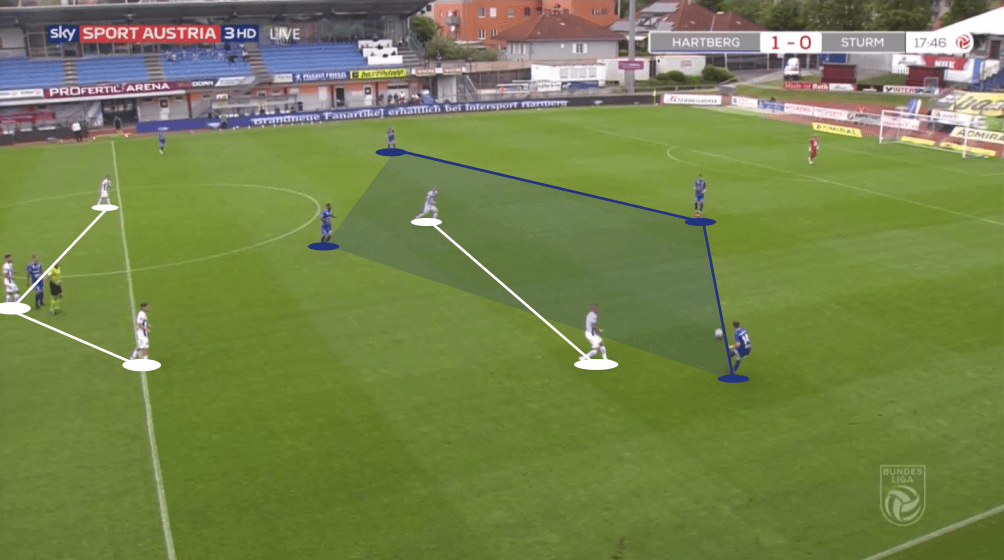
We saw in this game two pressing triggers of Sturm Graz: a backward pass from one centre-back to another or a lateral pass to one of the two outer men of the back three. As soon as a backwards pass has been played, Despodov and Friesenbichler started the press while when we look at the lateral passes, we could see two different patterns. When the ball was played to Hartberg’s left man of the back three (Klem) the right striker Despodov started the press. In the moments in which Rotter received the ball, Kiteishvili moved forward from the midfield three to support the two strikers up front as we can see below.
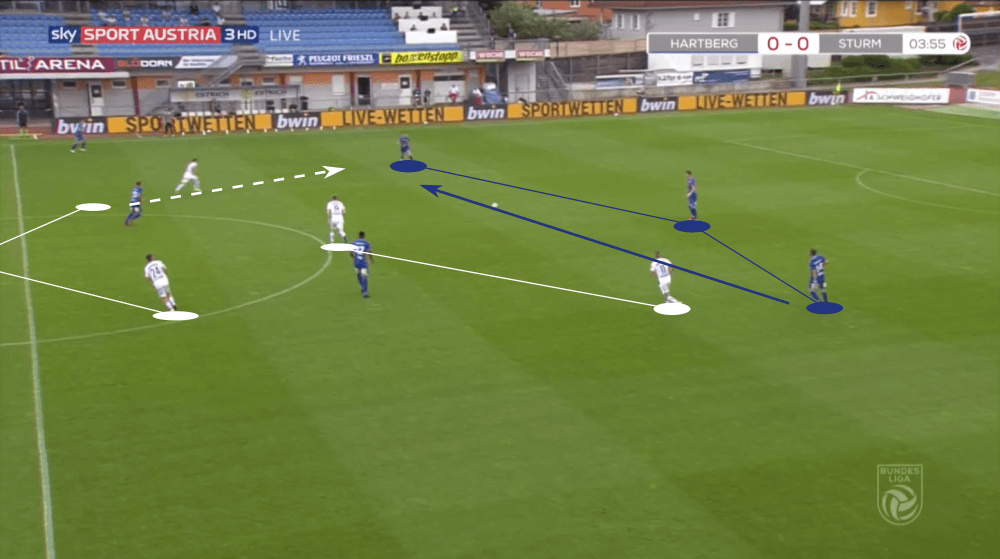
Nimaga was extremely important for his side as he was always the man in the centre who helped his teammates by providing a passing option. Rep often dropped deeper to get involved and they tried to get forward by using short passes. Also, we saw often interesting combinations on the left side since Dante and Tadić were quite flexible. In the image below we can see those aspects since Rep is positioned deeper and Tadić is near the touchline.
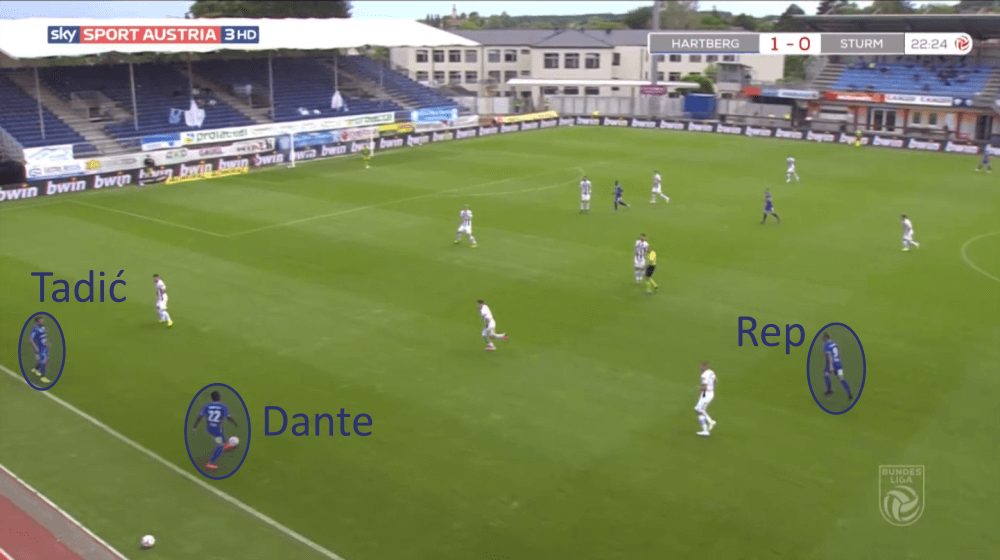
While on the left side little interplays and give-and-goes were the preferred ways to get forward, we often saw long balls to the right wide-area towards the wing-back Lienhart when Sturm Graz shifted over aggressively to the other side.
From there, the goal was to play as quickly as possible a trough ball behind the defence of Graz and exploit the pace of Dossou. Below we can see a situation in which they play a long ball to the right wing-back as he has a lot of space and immediately plays a through pass towards Dossou who is ruled offside.
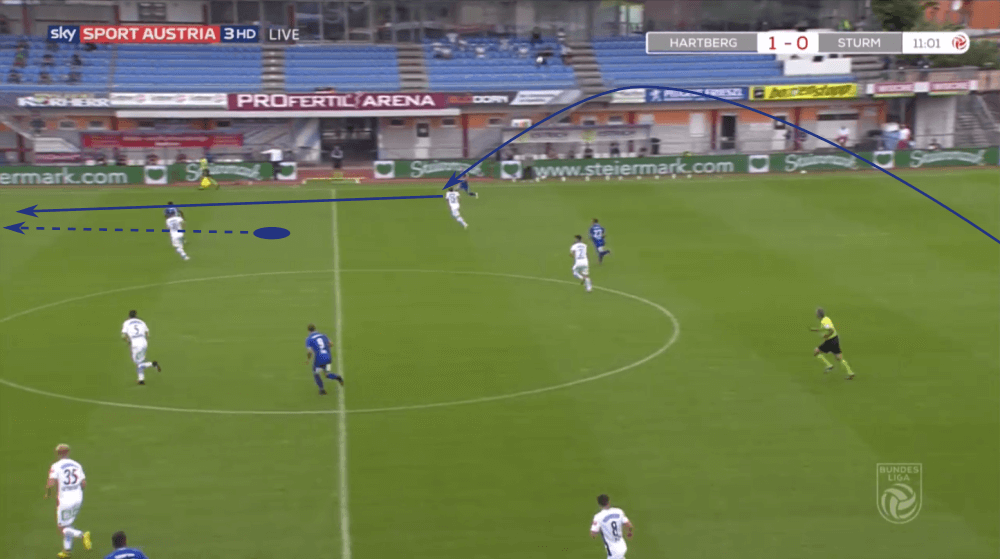
In general, one of the central parts of Hartberg’s tactics were long balls behind the defence of Sturm Graz. They mainly tried to find in those situations Dessous since he is the far quicker player compared to the 30-year-old Tadić.
No matter which player received the through pass (or in general, a long ball), one interesting aspect was that they constantly worked with counter-movements or different positions to lure an opponent out of his position and then a teammate could sprint exactly into this space. Below we can see an example for that as the right wing-back Lienhart is positioned quite deep which triggers the left wing-back of Sturm Graz (Hierländer) to get forward. Hartberg exploits the free space behind Hierländer with a long ball.
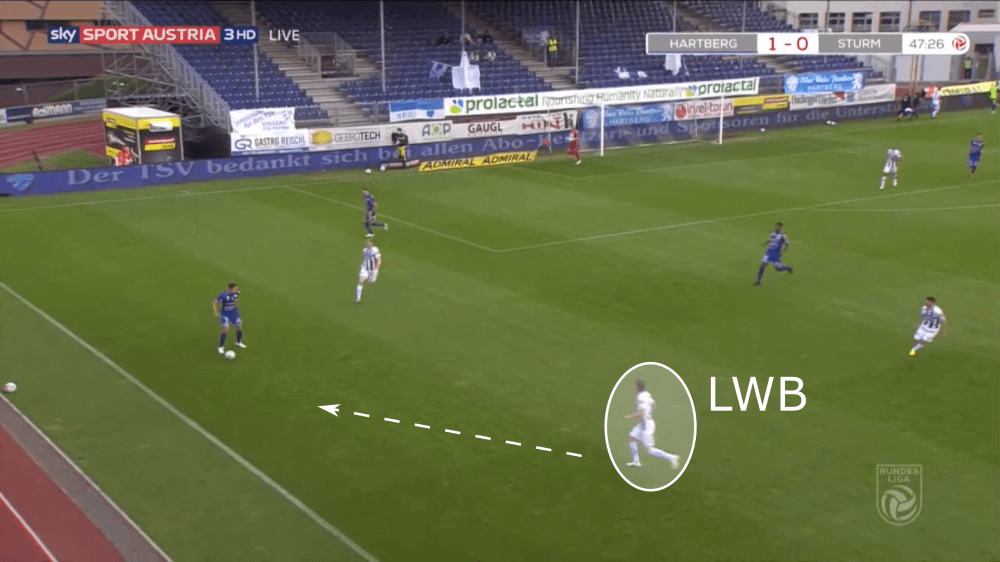
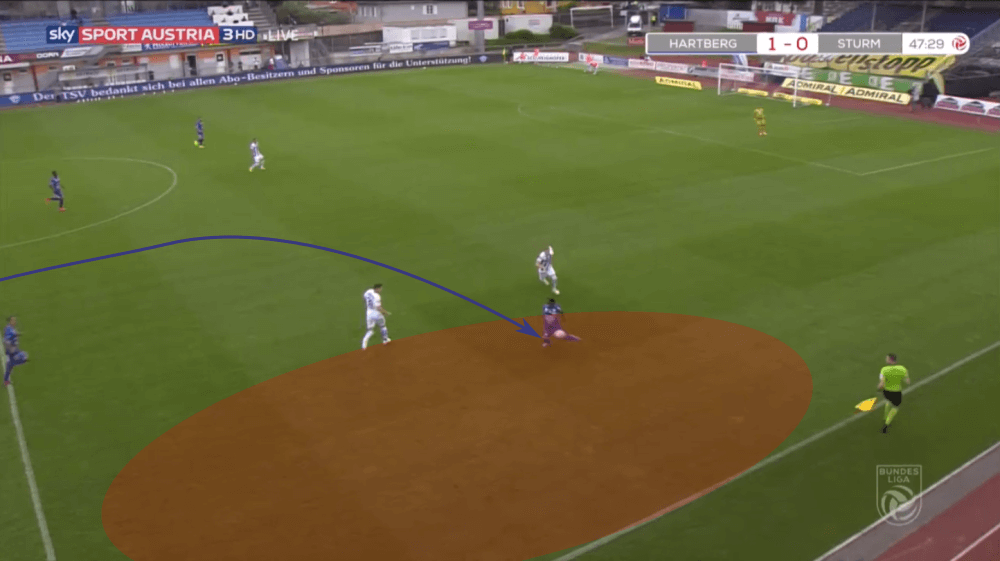
The problems of Graz in possession during the opening 45 minutes
Hartberg were extremely patient during the build-up and often easily bypassed the press of Sturm Graz as it wasn’t that aggressive and often the distance between the three lines (back five, three midfielders, and two strikers) was too long. The team of Schopp also often played the ball back to Swete who would then help them to create numerical superiority and then again build up the attack from scratch.
On the other side, Graz had huge problems when it comes to the progression of the ball during the opening 45 minutes. In the image below we can see the structure of Hartberg when the opposition started their build-up. The two strikers split and Rep was positioned between them to create a front three and therefore a 5-2-3/3-4-3 formation. On some occasions, Rep was also the man on the left side while Tadić was the central man.
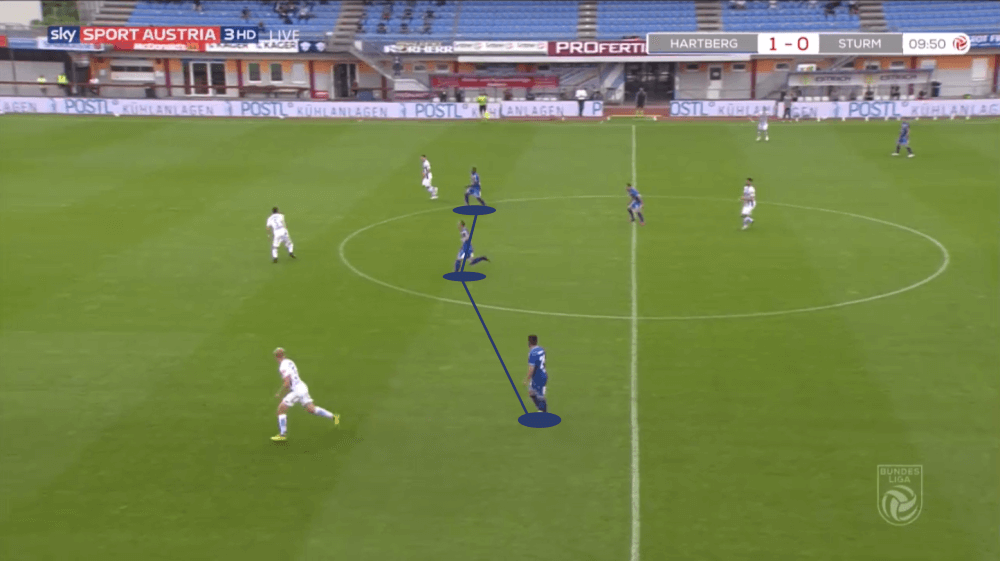
Sturm Graz had huge problems when they faced this high press as the three offensive men effectively cut off the passing lanes into the centre. However, since Sturm Graz had three central midfielders with Domínguez, Leitgeb, and Kiteishvili against the two midfielders of Hartberg (Kainz and Nimaga) you would expect them to try to get into the middle of the pitch to then make use of the numerical advantage.
However, we could often see that the three defenders of Sturm Graz weren’t brave enough to go for the line-breaking pass. Also, when the ball was played to the wing-backs in the wide-areas, they frequently had the chance to play the easy pass into the centre, but they acted too hectic due to the pressure by the opponent. Below we can see an example in which the left wing-back Hierländer received the ball from the left centre-back Ljubic and instead of the simple pass into the centre to Domínguez who is completely free, he goes for the long ball with his first touch.
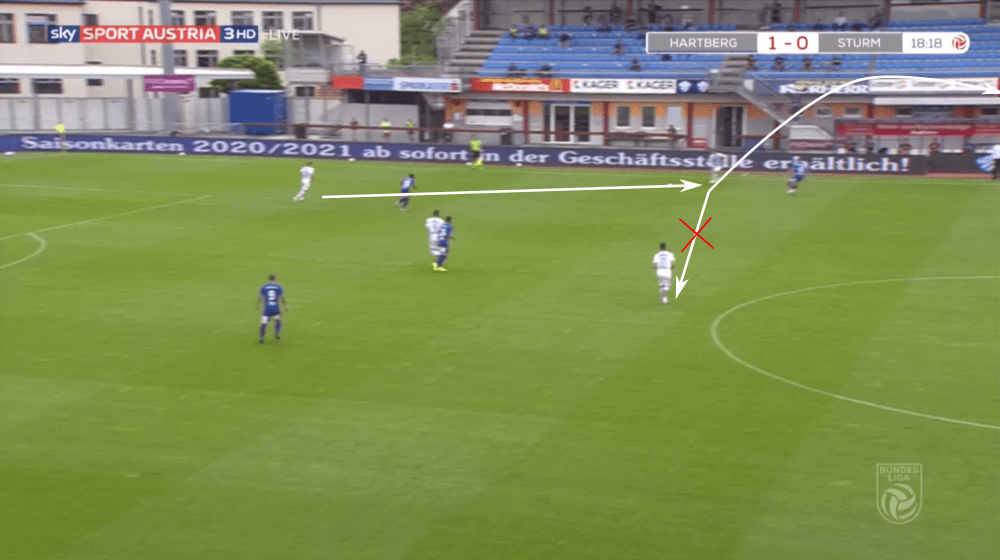
In general, Sturm Graz played a lot of long balls in the first half as they often didn’t play vertical passes behind the three offensive players of Hartberg. Up front, Friesenbichler and Despodov rarely were able to win the aerial duels or even win the second ball as they had a clear numerical disadvantage against the back three and Nimaga.
However, below we can see a situation which clearly shows why they should have tried more often to find one of the three central midfielders behind the first pressing line of Hartberg as the two central midfielders of the team of Schopp rarely joined the three offensive players during the press what led to a huge gap in the centre. In this particular example, Sturm Graz get into this zone, but then Domínguez has no forward passing options and plays a lateral ball to the left wing. They could have exploited this space way more often as this was one of the very rare occasions.
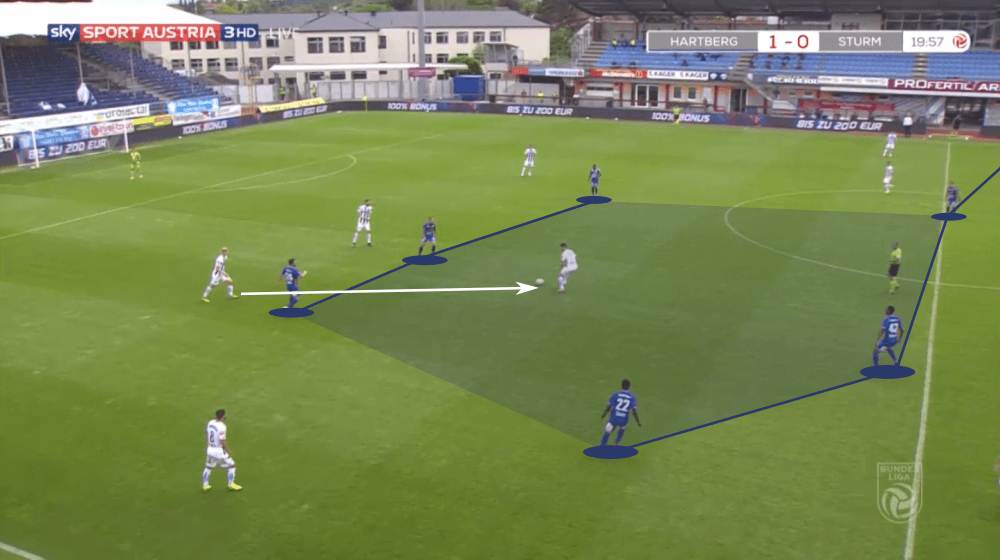
Overall, whenever Sturm Graz were able to get into the final third, this was mainly in the wide-areas. Whenever the wing-backs received the ball further up the pitch, they got isolated by the opposition and had almost no options. Also, their crosses rarely found a teammate in the centre as the positioning of the other players in the penalty box wasn’t good at all.
Below we can see a typical situation as Sakic received the ball from the right centre-back Lukas Jäger (got subbed on for the injured Geyrhofer), but was instantly pressed by Dante and he hadn’t even gotten the time to turn forward. Due to this, the wing-backs rarely had the chance to pick up speed or go into the one-on-one as they were instantly pressed when they received the ball and were positioned with their back towards the opposition’s goal.
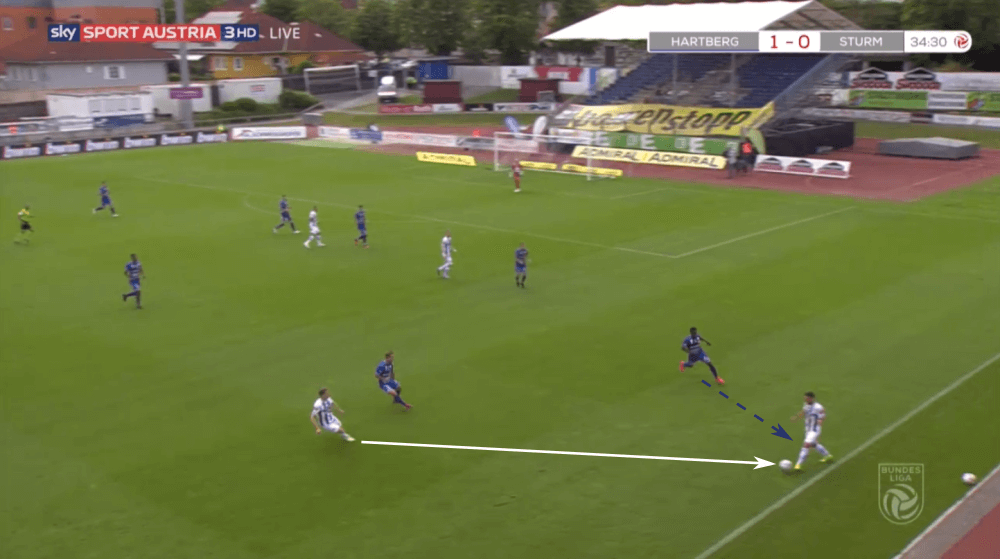
However, in the second half, we got a completely different game as we will see in the final part of this tactical analysis.
Changes in the second half
While in the first half, we often saw that the press of El Maestro’s side was extremely inefficient due to a lack of aggressivity and organisation, in the second 45 minutes this completely changed. Right from the whistle, Sturm Graz’s players sprinted towards the opponents when they pressed in at them while in the first half they focused more on cutting off passing lanes (which rarely worked). Also, the whole team pushed up together to avoid the gaps between the three lines as I noted earlier in this tactical analysis.
This meant that Hartberg would have more problems during the build-up which also led to more uncontrolled long balls and shorter periods of possession.
However, not only did the behaviour during the press of Sturm Graz change drastically but also their attacks were more straight forward and braver too. Both wing-backs played more offensive meaning that they didn’t just receive passes with their back towards the opposition’s goal (as we saw in an earlier example), but their teammates found them more frequently with through passes which brought them in better positions for crosses.
Sakic was especially way more active in the second half on the right side and improved the way how the occupied the penalty box ahead of the crosses. While in the first half there were only the two strikers in there who always got marked closely, in the second half the central midfielders and the opposite wing-back joined them. As they arrived at a later stage in the box, they often had no markers which meant that they were completely free.
In the first image below we can see how Kiteishvili moves into the box, receives a decent cross from Sakic (who received a high through ball and then could finally go into an actual one-on-one with his opponent) and shot with a decent volley which got saved by Swete. In the second frame again Sakic delivered a cross, but this time it is the left wing-back Hierländer who enters the box completely unmarked and misses the goal with a header.
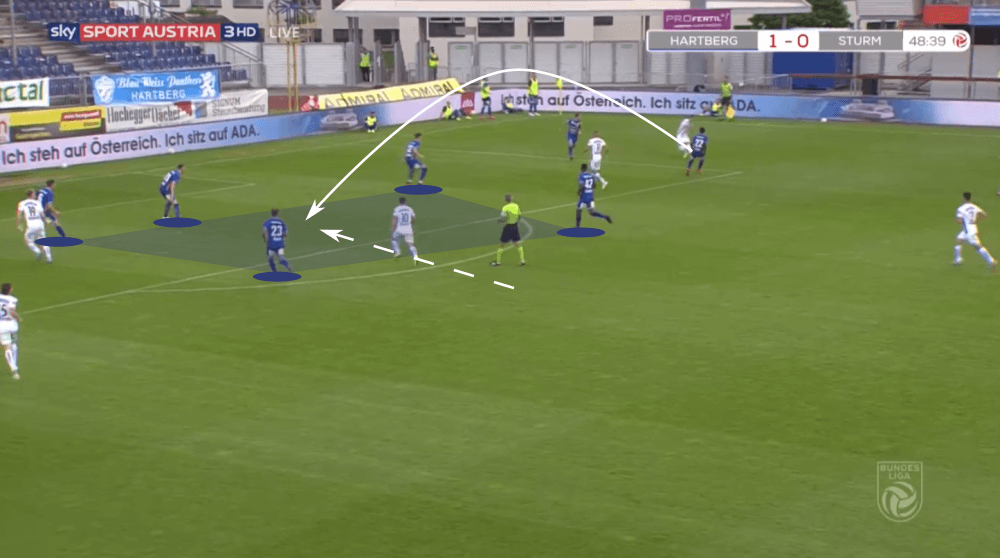
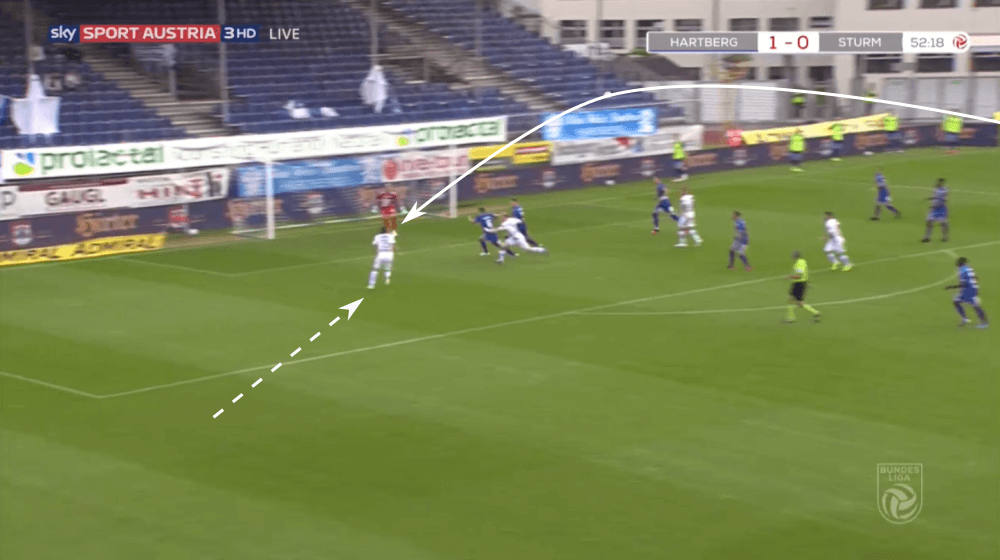
As we saw above, Dossou was often the target for through passes in the first half. This didn’t change in the second 45 minutes, but then it was more frequently during counter-attacks. Hartberg lost the control of the game and focused more on defending deep which lured out Graz and gave Schopp’s side more space for counter-attacks. An example can be seen below as Rep receives a vertical pass and plays a perfect through ball with his first touch, but Dossou shoots besides the goal in the one-on-one situation against the goalkeeper.
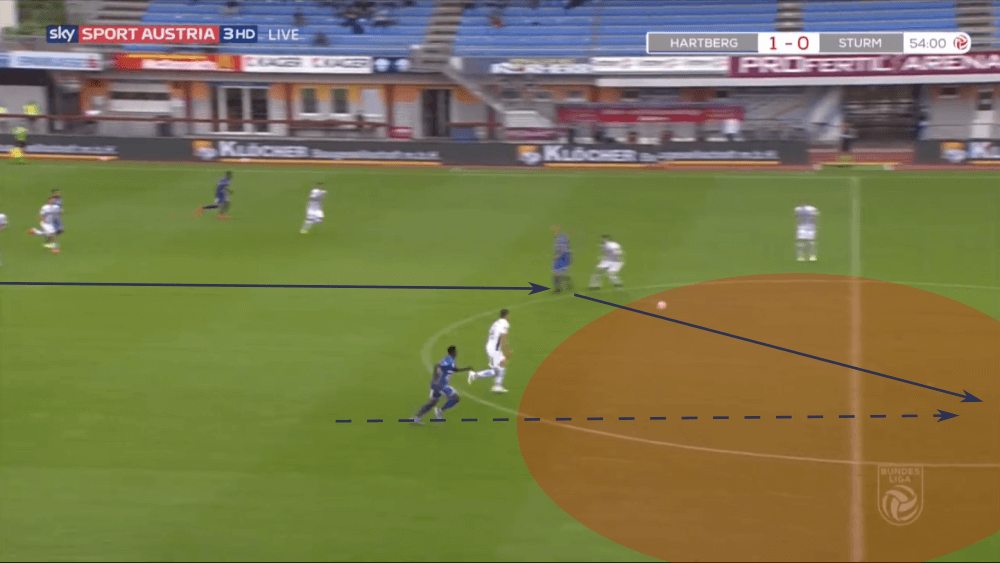
Conclusion
In the ninth minute, Kainz scored with a beautiful volley from distance and Hartberg deserved this 1-0 lead after the opening 45 minutes as they were the better side. Anyways, Sturm Graz got much better in the second half as their press got more aggressive, and they created several chances with the aid of crosses.
In the end, Despodov scored from two direct free-kicks in the last five minutes of the game to get Sturm Graz the 2-1 victory. Still, the team of El Maestro are in the sixth and last position of the championship group with 19 points. Hartberg are in front of them with 20 points while Wolfsberger AC collected 23 points until now and are in the third position which shows how close the race for the third rank is, as it is in this position you qualify for the UEFA Europa League while the first two qualify for the UEFA Champions League.




Comments